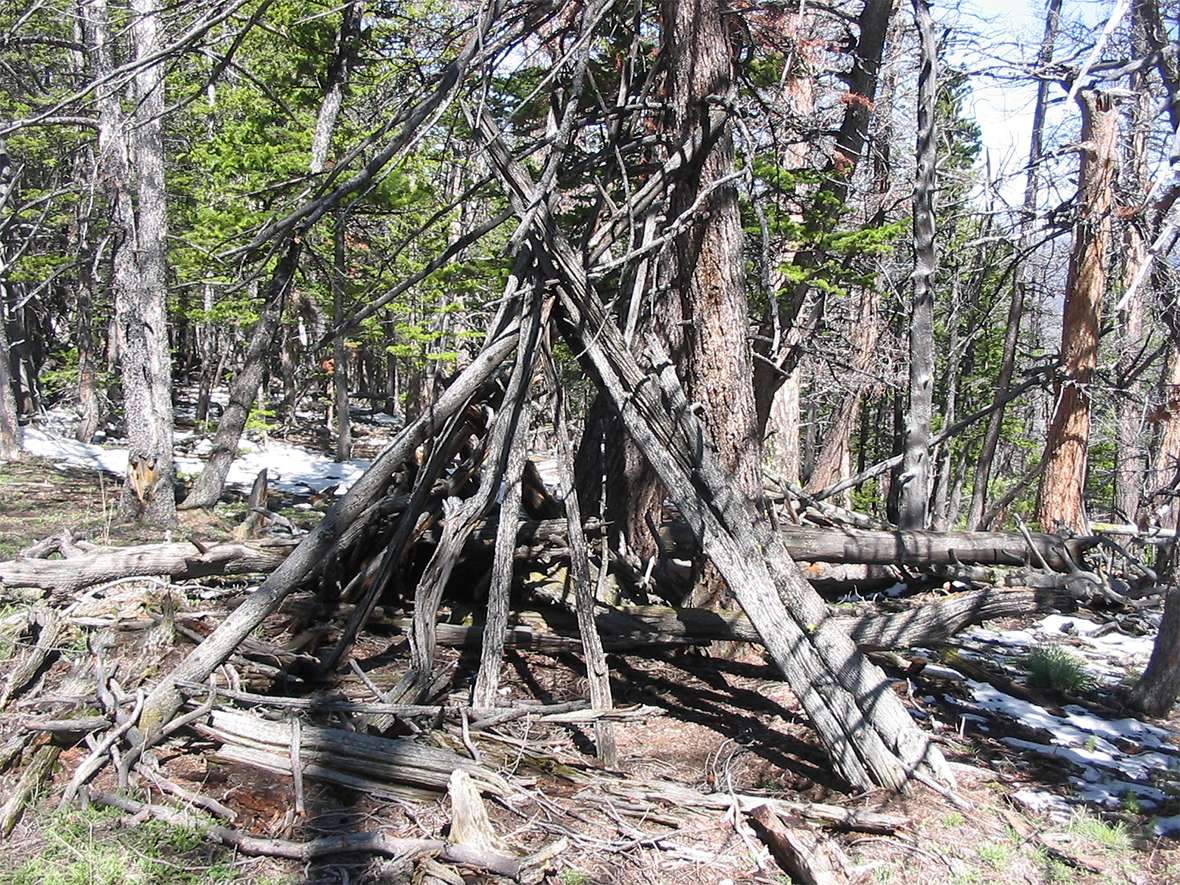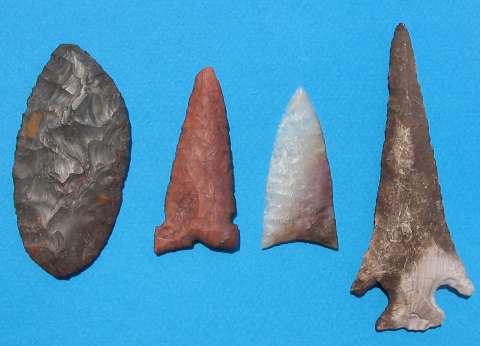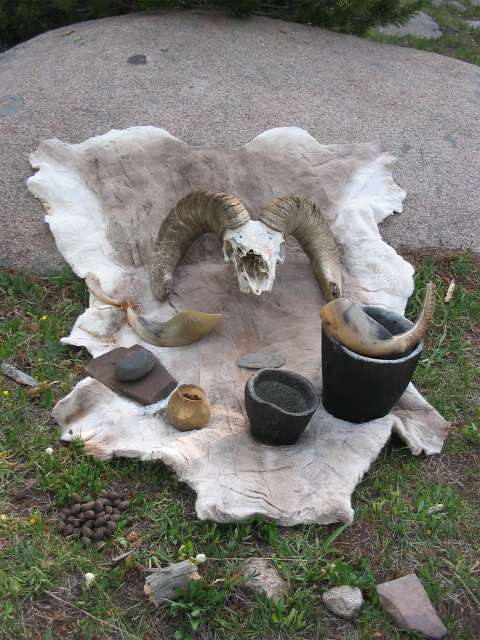- Home
- Encyclopedia
- The Mountain Shoshone
The Mountain Shoshone
Recent discoveries show ancient peoples lived in the mountains of what’s now northwest Wyoming, probably in significant numbers. Some or many of these people were most likely ancestors of today’s Shoshone.
While sources generally agree that the subculture of mountain-dwelling Shoshone came to be called Sheepeaters, scholars prefer Mountain Shoshone as the more accurate term. By the mid-1800s, they were regarded as largely separate from the horse-owning, buffalo-hunting bands that roamed much of what are now southwestern and central Wyoming and came to be known as the Eastern Shoshone.
The Mountain Shoshone hunted bighorn sheep in the mountains, along with deer, elk and many smaller mammals. They also ate fish and insects. In his book on the Mountain Shoshone, amateur archaeologist and historian Tory Taylor of Dubois, Wyo., cites ethnologist J. H. Steward, who wrote in 1943 that Shoshones gathered, dried and stored crickets, cicadas and grasshoppers.
The Mountain Shoshone also gathered a large variety of plants for food or medicine. Taylor, taking as his guide the current presence of alpine plants in the northern Wind River Range, suggests they probably ate mountain sorrel, spring beauty, marsh marigolds, wild strawberry greens, wild chives and 14 varieties of berries, along with cattails, burdock, dandelion roots and greens plus more than 50 other native plants.

They crafted ladles from sheep horns and built conical log dwellings, usually called wickiups—some of which still stand—and were pedestrians who probably used dogs for hunting and packing.
In prehistoric times, there may have been many Mountain Shoshone, as evidenced by dense assemblages of projectile points and other tools found high in the Absaroka Range of northwest Wyoming. Above 10,000 feet elevation in the Wind River Mountains, the discovery of whole villages—including the remains of wickiups—shows that living in the mountains, probably in summer, was common among prehistoric people.
Shoshone-associated artifacts found at these villages include teshoas—knives used by Shoshonean women—soapstone vessels and chert, quartzite and obsidian projectile points of the desert tri-notch, cottonwood triangular and rose-spring style. About ten or twelve years ago, in a mountain meadow near timberline in the Wind River Mountains, one member of a team that included Tory Taylor found a rare soapstone carving among many other Shoshone artifacts near a major source of soapstone. Archaeologists have also found items often associated with other tribes as well as the Shoshone, including metates and manos—mortar-and-pestle stone tools—used for grinding food.

Some sources suggest that because the Mountain Shoshone had few or no horses, they were impoverished compared to their equestrian relatives. It’s not clear whether the supposedly “low-caste” Sheepeaters, as they came to be known, were actually poor and ragged, and thus disdained by whites and Indians alike. This may only have been a cultural distortion.
Poverty may not have been why most Mountain Shoshone lacked horses. In rough country, horses are less versatile pack animals than dogs, and also weren’t necessarily an advantage in an environment where game animals were grazing just over the next ridge, rather than miles away across the plains.
Mountain Shoshone crafts
The Mountain Shoshone tailored clothing from sheepskin and other animal skins. Historian David Dominick reports that they were said to be expert tanners and furriers, trading their sought-after sheepskin robes for buffalo robes and other Plains Indian products.
Working soapstone was another important Shoshone craft. Archaeologists have found bowl fragments and occasional intact bowls in shapes resembling flowerpots, round casserole dishes and smaller vessels the approximate size of a teacup. Pipes, sometimes decorated with engravings, are either tube-shaped, onion shaped—in profile resembling a small vase—or elbow-shaped. Only a few beads have been discovered, ranging from pea-size to quarter-size.
Mountain Shoshone also manufactured bows from the horns of mountain sheep, sometimes from a single large horn, more often from two. White explorers, including Capt. Meriwether Lewis, described these bows in detail in their journals, with close attention to their construction and ornamentation.
The bows apparently were powerful and deadly. Tory Taylor recently made a sheep horn bow with help from Tom Lucas, a white Wind River Reservation native and craftsman of museum-quality replicas. When Taylor tested his new bow, he reported, “[i]t performed sweetly.”

Sheep horn bow manufacture is uncommon because few Shoshone or whites know how to make them, and also because suitable horns are rare. However, residents of the Wind River Reservation practice a variety of other traditional crafts, including beadwork, hand-tanning leather from game animals, making drums and wooden bows. At present, few non-natives are learning these skills, possibly because there is no procedure in place to facilitate this.
An evolving name
Anthropologists now suggest that band names of a variety of Shoshone groups—“Sheepeater” is only one example—began as transitory labels denoting economic activity and locale, and only later became attached, sometimes inaccurately or even pejoratively, to specific groups.
During the first half of the 20th century, ethnologists and linguists noted that Shoshone used a variety of food-names to refer to each other. Sheepeater, Tukudeka in the Shoshone language, was one of a half-dozen or more such terms. These names referred to the wide array of animals and plants that different people might hunt or gather at one time or another. Food-names may also have applied to the residents of regions where certain plants or animals predominated.
Historian David Dominick reported that in the late 1950s Sven Liljeblad, a linguist at Idaho State College, interviewed Northern Shoshone at the Fort Hall Reservation in Idaho about these food names. An interviewee identified as W. G., age 65, told Liljeblad, “Just whatever they [other Shoshone] ate at that time is what I called them. We could even call them ‘coffee-drinkers.’” Dominick mentions five food-names in addition to Tukudeka.
Thus, by what may have been common practice, an extended family harvesting seeds became known as “seed eaters” to other Shoshone who saw what they were doing. A group who hunted rabbits was called “rabbit eaters.” When a group moved to a different area, the name changed. For example, if they moved to an area where pine nuts were abundant, they became known as “pine-nut eaters.” This is probably the genesis of the name “Sheepeater,” which described what almost any Shoshone might have been doing, or possibly, where they lived.
Vagueness and confusion about who the Sheepeaters were and are seems to stem from relatively few, but powerful misinterpretations combined with differing observations that took hold early in the history of white encroachment and continued through time. For example, Dominick cites the conflicting reports of fur trader Capt. Benjamin Bonneville and mountain man Osborne Russell, both from 1835. Bonneville found Shoshone in the Wind River Mountains and described them as “a kind of hermit race, scanty in number [and] … miserably poor.” By contrast, Russell saw “a few [Shoshone] Indians” in Yellowstone Park, “all neatly clothed in dressed deer and sheepskins of the best quality and seemed to be perfectly contented and happy.”
The food label slowly became a group label that eventually stuck. Early white trappers and explorers, and later military men and Indian agents, gained the impression that the Sheepeaters were a distinct sub-tribe of mountain-dwelling Shoshone whose predominant food source was mountain sheep. White men who saw groups of Shoshone in the mountains referred to them as Sheepeaters, no matter what game animal was most plentiful in the area.
Starting in the mid-1800s, Sheepeater guides were engaged by parties of white explorers in the areas in and around what became Yellowstone National Park. Capt. William A. Jones refers to Sheepeaters several times in his report of a reconnaissance expedition to northwest Wyoming in 1873. This suggests that the idea of a subgroup, called Sheepeaters, had already begun to coalesce around earlier misinterpretations of the name.
Anthropologist Susan Hughes proposes that the label continued to evolve along with changes in tribal structure brought on by the presence of whites. Before the reservation era began in the 1860s, the most organized political unit among the nomadic hunting and gathering Shoshone was the winter village. Such villages generally contained no more than 15 families.

Alliances formed among these villages, and during warmer seasons larger groups gathered for hunting or social functions, Hughes notes. Leadership and group structure were informal and transitory until Indians of all nations, the Shoshone included, gathered and traveled together to provide better protection from groups of whites. Indians who negotiated with U.S. government officials about treaties and other matters were usually tribal leaders. Hughes suggests that organized bands with formal, permanent leadership appear to have been a late development and in part, a white man’s construct.
Adding to the confusion, some Sheepeaters—the Northern Shoshone—hunted on the west side of the Tetons in present Idaho, while others—some of whom became known as Eastern Shoshone—lived farther east—sometimes in the Green River Valley and sometimes in the Wind River Valley in present Wyoming. Northern Shoshone groups ended up on the Fort Hall Reservation in Idaho; the Eastern Shoshone, on the Wind River Reservation in Wyoming. To some extent, these may have been separate groups from earlier times, although all Shoshone people were and are related, regardless of the diversity of their ancestors’ hunting and gathering locales.
When Shoshone bands first came to the Eastern Shoshone Reservation, they generally lived in separate areas, elder John Washakie says now, and that pattern continued for some time. Distinctions “became more blurred” as people moved into modern housing, he said. Currently, the Shoshone who now identify themselves as Sheepeaters trace their lineage to one ancestor or another who was a Sheepeater, such as Togwotee, the well-known guide, for whom Togwotee Pass is named.
Conclusion
There’s no doubt that ancient peoples lived in the mountains of northwest Wyoming and on the western side of the Tetons, probably in significant numbers. Drive lines, hunters’ blinds—either pits dug in the ground or stone structures—and remnants of corrals at the foot of short cliffs all point to the herding and slaughter of mountain sheep. It’s also certain that Shoshone food-names began as transitory labels denoting economic activity and locale and evolved into something more like the identity of a definite group.
Resources
Primary Sources
- Taylor, Tory. Telephone interviews with author, April 23, 24, 2018.
- Washakie, John. Interview with WyoHistory.org Editor Tom Rea, May 7, 2018.
Secondary Sources
- Adams, Richard. “Archaeology with Altitude: Late Prehistoric Settlement and Subsistence in the Northern Wind River Range, Wyoming.” Ph.D. diss., University of Wyoming, 2010.
- Accessed Jan. 31, 2018, at www.proquest.com. Database at the University of Wyoming Coe Library. Available to faculty, staff and currently enrolled students.
- DePastino, Blake. “Wyoming Wildfire Reveals ‘Massive’ Shoshone Camp, Thousands of Artifacts.” Western Digs. Accessed April 21, 2018, at http://westerndigs.org/wyoming-wildfire-reveals-massive-pre-contact-shoshone-camp-thousands-of-artifacts/.
- Dominick, David. “The Sheepeaters.” Annals of Wyoming 36, no. 2 (October 1964): 131-168. Accessed Feb. 20, 2018, at www.archive.org/details/annalsofwyom36121964wyom. The article includes the Sven Liljeblad interview with W. G. at the Fort Hall Reservation in Idaho.
- Hughes, Susan S. “The Sheepeater Myth of Northwestern Wyoming.” Plains Anthropologist 45, no. 17 (February 2000): 63-83.
- Hultkrantz, Ake. “The Shoshones in the Rocky Mountain Area.” Annals of Wyoming 33, no. 1 (April 1961): 19-41. Accessed March 9, 2018, at www.archive.org/details/annalsofwyom33121961wyom.
- Jones, William A. “Report on the Reconnaissance of Northwestern Wyoming Made in the Summer of 1873.” Washington: Government Printing Office, 1874. Accessed April 23, 2018, at
- https://quod.lib.umich.edu/cgi/t/text/text-idx?c=moa&cc=moa&view=text&rgn=main&idno=AGH6142.
- Loendorf, Lawrence L. and Nancy Medaris Stone. Mountain Spirit: The Sheep Eater Indians of Yellowstone. Salt Lake City, Utah: University of Utah Press, 2006.
- Stirn, Matthew. “Modeling site location patterns amongst late-prehistoric villages in the Wind River Range, Wyoming.” Journal of Archaeological Science 41 (2014): 523-532. Accessed Jan. 26, 2018, at
- https://www.researchgate.net/publication/262068198_Modeling_site_location_patterns_amongst_late-prehistoric_villages_in_the_Wind_River_Range_Wyoming.
- Taylor, Tory. On the Trail of the Mountain Shoshone Sheep Eaters: A High Altitude Archaeological and Anthropological Odyssey. San Bernardino, Calif.: Wind River Publishing, 2017.
- Todd, Lawrence. “A Record of Overwhelming Complexity: High Elevation Archaeology in Northwestern Wyoming.” Plains Anthropologist (Memoir 43), vol. 60, 2015, no. 236: 67-86.
- Todd, Lawrence, Rachel Reckin, Emily Brush, Robert Kelly, and William Dooley. “An Alpine Archaeological Landscape in the Greater Yellowstone Ecosystem, Wyoming.” Society for American Archaeology 82 Annual Meeting, Vancouver, BC, Canada. Accessed March 19, 2018, at http://www.grsle.org/Conferences/Todd_etAl_SAA_2017.pdf.
- Todd, Lawrence, Emily Brush, and Kyle Wright. “Forty Days in the Wilderness: 2015 Park County Historic Preservation Commission Archaeological Inventory and Assessment on the Shoshone National Forest, Wyoming.” January 2015, Plains Anthropological Conference, Iowa City. Accessed March 19, 2018, at http://www.grsle.org/Fieldwork/ToddEtAlPlains_2015.pdf.
- Todd, Lawrence, Rachel Reckin, Emily Brush, and William Dooley. “Migration Corridors, Ice Patches, and High Elevation Landscapes.” Accessed March 19, 2018, at http://www.grsle.org/Conferences/Todd_et_al_2016_Elk&Ice.pdf.
Illustrations
- All photos are by Tory Taylor. Used with permission and thanks.
